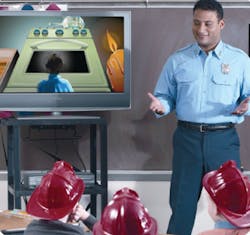To help that effort, the National Fire Protection Association contracted with the Johns Hopkins Center for Injury Research and Policy, in Baltimore to figure out the best way to communicate safety messages to kids 4 to 9 years old. The study, funded by a U.S. Department of Homeland Security, Federal Emergency Management Agency Fire Prevention and Safety grant of more than $600,000, found that kids respond to positive messages with parental reinforcement and guidance.
During NFPA's conference and expo in Boston earlier this month, the findings of the research was presented to a meeting room packed with fire service personnel, educators and a host of other interested parties.
"The take away is children respond better to positive messages with guided parental discussion," said Dr. Rajiv Rimal of John Hopkins Bloomberg School of Public Health, who was a co-investigator for the study.
The study, which resulted in the creation of an 84-page document, said: "Overall, findings from this research suggest that the impact of safety messages on children will be greatest when framed positively, parents are encouraged to discuss these messages with children, and parents are provided with discussion guidelines."
During the NFPA presentation of the study, Dr. Andrea Gielen, also of John Hopkins Bloomberg School of Public Health, who was also the primary investigator, outlined the method by which the study was conducted.
Gielen explained that NFPA conducted a similar study in the 1970s. That study showed that positive messaging reinforced with telling people what to do was the most effective means of communicating safety information to children and adults alike. In the almost 40 intervening years, a lot of different media and cultural influences may have affected the original premise, she said.
"It was certainly worth revisiting," Gielen said. "We learned how to instruct children with a positive message." She added that it was the first time NFPA and John Hopkins collaborated. "It's been a wonderful experience."
To conduct the test, the researchers used a marketing agency to recruit 641 pairs of kids and parents arranged in two groups -- one group of 4 and 5 year olds and another of 6 through 9 year olds, according to Gielen.
The demographics reflected that of Baltimore city in education, sex, race and marital status, she said. When the test subjects were selected, each group was shown age appropriate videos with fire safety messages in them. Younger kids were shown animated messages about putting cool water on a burn and another about getting low in smoke conditions. The older kids were shown live action videos, featuring other kids, with similar messages.
Simplifying the methods used, Rimal said message were framed either positively or negatively such as "if you don't play with matches, you'll be able to protect yourself. Or in a negative manner such as "if you play with matches, you'll burn yourself."
Parents who participated in the study were either told to just talk to their kids about what they had seen, others were given specific talking points to guide and reinforce the fire safety message the kids had just witnessed, Rimal explained. A third set of parents in the sample were given no instruction either way.
Parents were also given questionnaires regarding the safety messages and John Hopkins internets interviewed the kids after the viewing to determine what they had learned and how they related to it.
Another John Hopkins participant, Dr. Dina Borzekowski, said the researchers were careful to make sure context and questions were as realistic as possible and in all cases, parents and kids were given the correct information before they left the testing location.
Borzekowski said that because study concluded that children did better answering questions fire safety after parents had guided talks with them, it illustrated the importance of parental involvement in fire safety education.
"It also showed that we have to be very careful with the messages we give to the parents," she said.
All three researchers were surprised at the apparent lack of knowledge some parents had about fire safety including the fact that butter should not be put on burns of any kind. Many parents, they said, believed that was an appropriate action.
Rimal said the groups that did the worse in correctly answering the intern questions were the ones where the parents were simply told to talk to their kids about what they saw.
"That proves it's not enough to just tell parents to talk to their kids about fire safety," Rimal said, noting that to be as successful as possible with any kind of fire safety education it needs to be backed up with parental education and provided talking points.
Tangentially Borzekowski said the study reinforces the need for fire educators to keep message simple and to present no more than three concepts at any one time.
"We need to keep it simple," she said.
In addition to the report, the research funded by the grant resulted in guide available to firefighters and safety educators titled "Evaluating and Creating Fire and Life Safety Materials: A Guide for the Fire Service."






